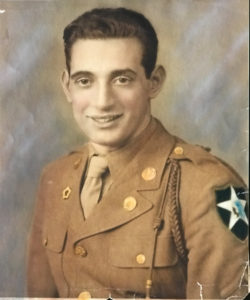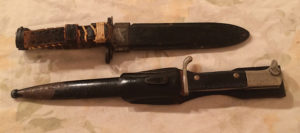
New member William Jannace recently joined to honor his father, Anthony E. Jannace, 2 INFD 2 ENGR CMBT BN. The Second Infantry Division was part of Patton’s Third Army and the rush across Europe. From D-Day’s second wave (June 7, 1944) until May 7, 1945, the Second Infantry Division spent approximately 303 days in combat. They fought in St. Lo France, Alsace, the liberation of Paris, Belgium, Germany and Czechoslovakia. Like so many of his comrades, Anthony Jannace got frost bite during the Battle of the Bulge. He received the Purple Heart after being hit by a mortar on April 7, 1945.
The Second Engineer Combat Battalion was awarded a presidential citation for its activities from December 13-20, 1944 in Belgium. The citation reads:
“The Second Engineer Combat Battalion is cited for outstanding performance of duty in action against the enemy during the period, 13 December 1944 to 20 December 1944 in areas around Wirtzfeld, Belgium.
As its initial assignment, the Battalion proceeded to remove numerous road blocks, obstacles, and minefields on the only available supply road for the attack of the Division. This work was done under heavy artillery and mortar fire, within sight of the enemy, against adverse weather and over snow blanketed minefields. This road was cleared and opened up abreast, or even ahead of the assaulting Infantry troops advancing in the woods on either side.

With the sudden German counter offensive in the West, one company of the Battalion was sent from the rear in bivouac and suffered severe casualties. Pulling itself together, this company furiously fought back against the German armored spearhead, destroying several tanks and many Infantrymen. Pocketed elements held out for three days, though completely surrounded , until all ammunition and food was exhausted, when they were finally overcome.
Still other elements of the Battalion were twice thrown into the line as the only Infantry reserves to withstand the German push in the rear flank of the Division. Another company constructed a final barrier and obstacle belt behind our withdrawing Infantry. Mines, road blocks and demolitions were placed under heavy enemy fire and amidst infiltrating enemy Infantry on all sides, thus delaying his pursuit of our withdrawal. Without rest from duties or clearing roads for advancing fighting as Infantry, and placing road blocks and obstacles for withdrawal, the Second Engineer Combat Battalion took up its all important mission of keeping the only escape route for the Division open. This was a newly constructed one way road across swamps and hills which in spite of severest conditions of melting snow and ice, drizzling rain, was kept passable for the never-ending columns of tanks and trucks of the major part of two Divisions which had to withdraw over this route. The men of the Battalion worked unceasingly, night and day, until the last vehicle of the Division was successfully extricated.
All through the days of attack and withdrawal, the Second Engineer Combat Battalion skillfully, speedily, and courageously executed their tasks to assist and protect the Second Infantry Division in its combat missions. Through the seven day period, the Battalion worked and fought continuously suffering approximately twenty five percent casualties. The outstanding performance of the officers and men of this unit, under exceptionally difficult and hazardous conditions, exemplifies their deep devotion to duty and the highest traditions of the Corps of Engineers and the United States Army.”
